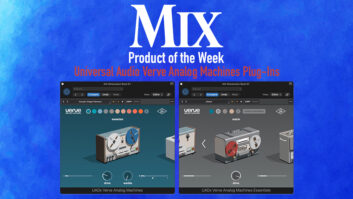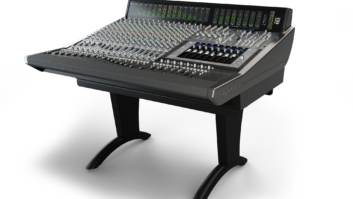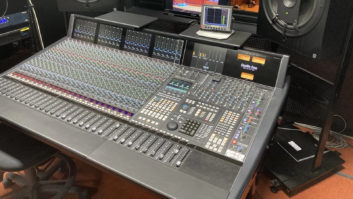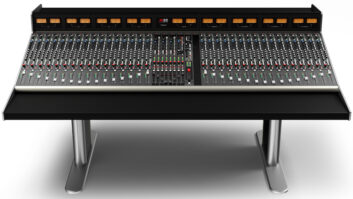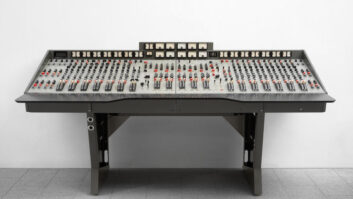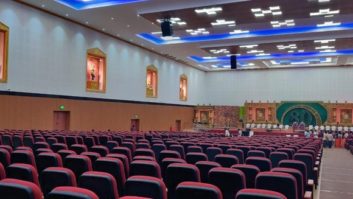For the first time in nearly 20 years, AMS Neve is launching an all-new analog console. “For years, studios have been asking for a new analog Neve,” explains managing director Mark Crabtree, “and we’ve been listening very carefully.” The result is the 88R, a new design offering the latest low-noise components with an impressive feature set that combines the best attributes of Neve’s popular V-Series music desks with advanced Encore automation and the multiformat surround mixing flexibility of Neve’s DFC (Digital Film Console).
Available in frame sizes from 48 to 96 channels (larger custom boards will be available), the 88R is an in-line design with 48 multitrack outs and six main outputs. Eight auxes are mono/stereo configurable in any combination, and auxes can be routed from the multitrack buses for more – lots more – aux sends for mix sessions, when multitrack sends are not in use. Monitoring/panning for 5.1 is standard, as is an expanded automation system that includes moving faders on main and small faders. A high-res TFT display is built into the console to show automation and status data, an S-VGA output will drive an external display, and a trackball and QWERTY keyboard provide the automation data input interface. An automation upgrade means that more events are automatable, including A/B input switching and crossfade panning, and in/out control of aux sends, inserts and EQ.
The 18dB/octave HP/LP filters are unchanged from the V Series, though they can now be used in either the channel or monitor paths. EQ can be pre/post-dynamics and retains that V sound, but with more cut/boost on all four bands (ñ20 dB). The Q range on the mid-bands is extended, and the HF band goes out to 18 kHz. The low-mid EQ goes 100 Hz lower, and the LF band extends 100 Hz higher for more overlap between bands. The compressor/limiter/gating in each channel module is now more versatile. Soft knee operation is standard, as is a wider range and +10 dB more sensitivity in the gating action. Compressors can be linked, and EQ can be inserted into the gate sidechain.
Options allow users to tailor the console to individual needs. Choices include a classic Neve compressor across the stereo outputs, a 5.1 compressor and either standard mic/line or dual-line I/O modules. The mic/line module has an upgraded mic preamp; the dual-line is aimed at facilities that do more mixing than tracking. Additionally, the extra line inputs dovetail with Neve’s new remote-controlled mic amp rack, which routes line-level signal to the control room; this way, the engineer has fingertip control of gain, phase, phantom power and pad. Three remote mic amp modules are available: the standard mic amp (same as the stock 88R preamps), Neve’s classic 1081 preamp, or the microphone amplifier that was designed for George Martin’s Montserrat console in the 1970s.
“It’s a totally new console,” says product specialist Jason Power, “but we’ve tried very hard to retain an element of familiarity to engineers who’ve worked on our V Series and other consoles. For example, the solo system is similar to that of the V Series, the layout of the channel strip and fader panel is largely unchanged, and the Encore automation has a Flying Faders feel, especially in the way that users set the record/safe/isolate modes. We want users to feel at home on the 88R.”
That said, the 88R has numerous design changes, from the inside out. The frame itself is different – the 88R’s curvy exterior is more like the Neve 8068. An acoustically treated back surface improves control room acoustics by reducing the reflections and, unlike the V Series’ solid back, the 88R’s open bottom design doesn’t trap bass under the console.
The 88R’s metering has a new look. The plasma displays of the V Series are gone, replaced by red LED bar meters, which offer 6 dB more sensitivity, now going up to +9 dB. Either PPM or VU-style ballistics can be selected with single dot peak (auto reset) or peak-hold display, and in calibration mode the entire range of the meter is ñ1 dB.
Under the hood, the emphasis is on sonic performance. There are no VCAs in the audio path, except as gain elements in the onboard compressors. “We’ve gone for a clearer, more open high end, to add some `air’ and better defined bass for a totally musical sound,” says design engineer Robin Porter. “Parts have improved a lot since the V Series, and we chose some of the newer op amps with much lower power consumption, lower noise and better slew rates than those devices used in the V Series.” Small details were not overlooked. “We spent a lot of time improving heat management,” Porter adds. “The 88R runs cooler than the V Series, and a `chimney’ effect draws air up through the console, redirecting heat away from the channel modules.”
The 88R was built with surround mixing in mind. Five stereo mix buses and a dedicated LCR bus can be run from the large or small faders. The LCR panning provides two divergence settings – wide or narrow. The 5.1 monitor control uses a passive 24-position stepped attenuator, and three sets of speakers can be selected: The large speakers are six-wide; the small and mini are three-wide. The console powers up in stereo but can be selected to work in 5.1, 7.1, 4-track, stereo or mono. In stereo mode, pressing the mono button sums the left/right buses and plays them equally on two speakers; however, in 5.1 mode, when mono is selected, all buses are summed and sent to the center speaker. Further, a speaker solo function can mute all speakers except the one selected, for checking placement levels, track problems, etc.
The console has four stem inputs that are eight-wide, yet the monitoring is only 6-track; an 8-track-wide VST film-scoring panel from the film console can be added to the 88R as an option. Also adapted from the DFC is a full machine control panel that can run up to six stereo machines directly, or up to 33 machines over ES-Bus or Lynx interfacing, with all track arming taking place from the console.
Dolby switching is provided, for ease of listening to 5.1 mixdowns to 4-track Dolby – and/or hearing a 5.1 or 4-track as Lt-Rt. “This is something that people wanted,” Porter explains. “There’s a fair amount of 5.1 or 7.1 cinema projects, but there’s still a lot of 4-track and stereo work. Users need to make sure that mixes sound okay over many formats.”
The AMS Neve 88R debuts at the 109th AES convention in Los Angeles. Initial deliveries will begin later this year.
